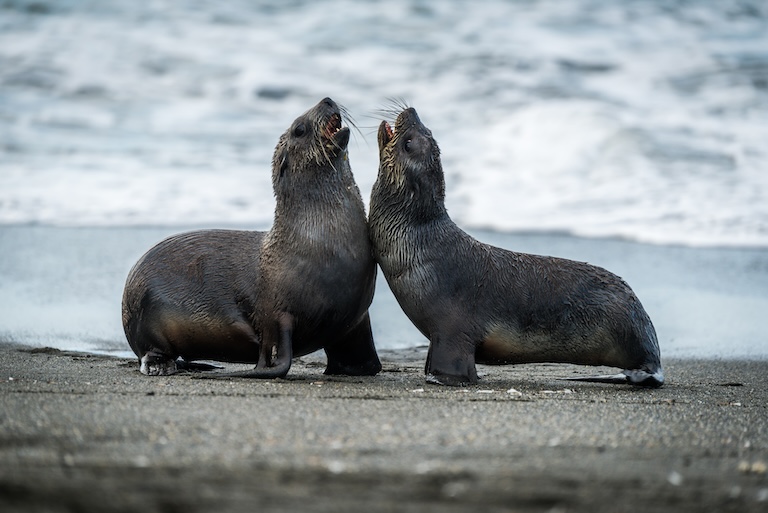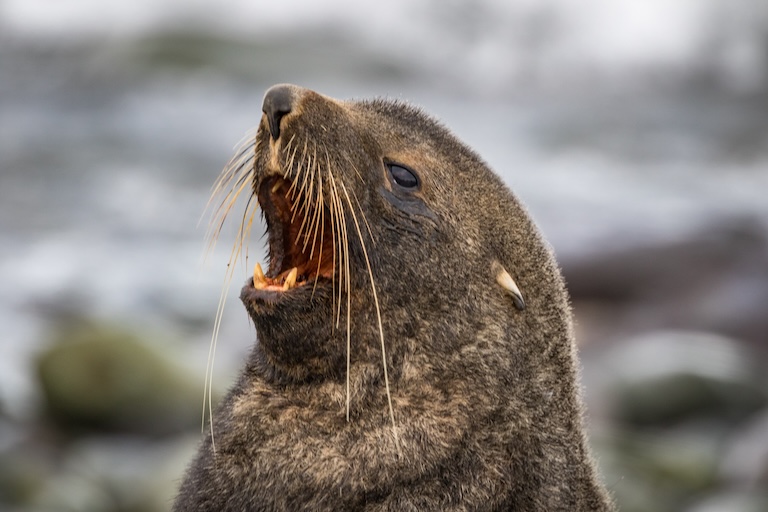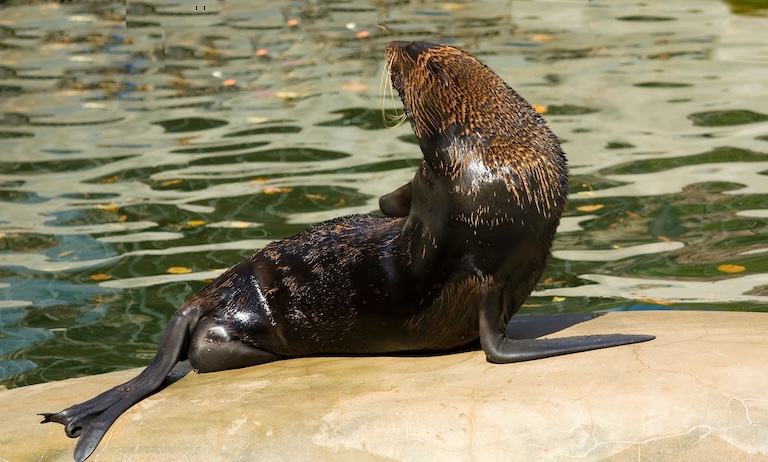Fur Seal Profile
Pinnipeds are a bunch of blubbery carnivores whose global success comes despite the fact that they have webbed feet and move about like encumbered caterpillars on land.
There are around 34 species today, split into three major groups: The walruses, the true seals, and the sea lions. Within this group of sea lions exists a subcategory inherently disruptive to intuition: the fur seals.
These powerful marine animals have a long history of persecution as a valuable food source historically, to a luxury commodity for the wealthy in more recent times. Today, many are struggling to bounce back from centuries of destruction.

Fur Seal Facts Overview
| Habitat: | Coastal marine |
| Location: | Most of the Southern Hemisphere, |
| Lifespan: | Up to around 25 years |
| Size: | Up to 2.3 meters (7.5 ft) long |
| Weight: | Up to 360 kg in large male Brown Fur seals |
| Colour: | Usually greys and browns, from light to almost black |
| Diet: | Bony fish, cephalopods |
| Predators: | Sharks, orcas, humans, sea lions |
| Top Speed: | 20 km/h (12 mph) |
| No. of Species: | 9 |
| Conservation Status: | Least Concern to Endangered (IUCN) |
Fur seals are sea lions, or “eared seals”, rather than their smooth-headed namesakes the true seals. They make up almost half of all pinnipeds, and have demonstrated wide success from Antarctica to the Arctic latitudes.
Of the nine species, they range from about 50kg to 350kg and display a variety of social behaviours and feeding patterns. All are well-honed predators of fish and cephalopods, and unlike the elephant seals and the walruses, all are far too cute to deserve the fate we’ve given them.
Interesting Fur Seal Facts
1. They have ears
The easiest way to tell a seal from a sea lion is to look for ears. Sea lions have an extra syllable in their name, and this comes along with an extra set of skin flaps on their faces.
True seals are ear-less, and this rings true for the ten or so species of Phocid, or true seal. But on the other branch of the pinnipeds, you’ve got the sea lions, and these are in the Otariidae family, named after the Greek for “little ear”.
All well and good, except that a branch of these Otarid sea lions are known as fur seals, scrambling the general rule that seals don’t have ears.
To make matters worse, there are as many species or “eared seals” as there are true seals, so it’s not a very good law until you dismiss the common naming system.
This wave function of confusing taxonomy can be collapsed simply if you consider that fur seals are just badly named sea lions.
This is taxonomically accurate: the subfamily of fur seals, Arctocephalus, sits right under the sea lion family, so there’s no going back! Fur seals are sea lions, no matter what you call them. 1

2. There are a lot of them
There are two genera in the fur seal subfamily, Arctocephalus, containing at least eight species of Southern Hemisphere fue seals, and Callorhinus, with the single species of Northern fur seal, and the only fur seal to live above the equator.
The Southern group spend about 70% of their time in subpolar and temperate waters and can spread all the way up to the Galapagos. Only one species from the Southern group, the Guadalupe fur seal, spends any time in the Northern Hemisphere, but the true king of that realm is the Northern fur seal.
Northern fur seals are some of the largest of the lot and the only remaining species in their genus. These huge animals are well adapted to the cold and temperate waters of the West Coast of North America and the East Coast of Russia.
So, between them all, fur seals are dotted across the entire globe, from pole to pole.
3. They have excellent senses
One thing they all have in common is a highly specialised set of senses for navigating their environments. Millions of years of being hunted by terrifying sharks and orcas has persuaded fur seals to stay very alert and they do that using a mixture of organs.
They have well-developed eyesight and great hearing, and when it’s their time to act as predators, they have a thick, powerful skull with large canines.
These animals may look cute, but they’re the equivalent of a marine bear; highly adapted carnivores and successful hunters. 2
4. Northern fur seals are highly pelagic
Most fur seals stay put for the year, roosting in large colonies on land and taking part in diurnal hunting expeditions.
The Northern fur seal is an exception and has been known to migrate up to 10,000km. These are some of the most pelagic pinnipeds, spending the majority of the year at sea. Males spend an average of only 45 days ashore during this time, and once juveniles enter the water they may not leave it until they’re ready to reproduce. 3

5. Australian fur seals are huge
Another giant species sits at the opposite end of the planet, and far from being small-group, pelagic animals like the Northern fur seal, these ones enjoy the coastal waters of Australia with hundreds of their friends.
Considering the plethora of large marine predators in the coastal waters of Australia, it’s probably a smart idea to stay in colonies like this.
These Australian, or Brown fur seals are also very large and nudge past the Northern fur seal’s weight limit as the largest of them all. The species is separated between Australian and South African populations, though the two never come together. 4
6. Many have been clubbed to death
Clubbed to Death is an excellent Rob Dougan track that has nothing to do with seals, but is a play on one of the most high-profile mass slaughters of the previous centuries.
There’s not a good way to kill a large mammal. They bleed a lot and usually don’t die immediately, no matter how hard you try. One of the fastest ways is by cracking them over the head with something heavy, yet it was this very method of killing seals that drew a public outcry in the ‘70s.
There were two issues: first of all, baby seals are cute, and seeing them brutalised was upsetting; and second, they were being killed for something most people watching didn’t consume: their fur. Public opinion was that it’s only good to brutally slaughter baby animals that have been born into captivity, and for things that the common folk can afford to enjoy, like their flesh.
But there was more than just mindless hypocrisy at play here, seal hunting was occurring at unsustainable levels, and many populations, including the fur seals, were rapidly declining.
Many populations, notably the Guadalupe fur seal, Northern fur seal, and Brown fur seal, suffered dramatic declines and are still recovering.
7. Some are not recovering well
Seal hunting has of course been widespread for hundreds, even thousands of years, but the increase in technology and tactics led to a massive ramp-up that is still a threat to seal populations today.
Galapagos fur seals were one of the worst hit. By the 20th century, they were almost extinct and only started to stabilise in 1959, when most of the archipelago was declared a national park.
Today, the species is still Endangered, and while hunting pressure has relieved, the combined effects of multiple climate change factors threaten to delay their recovery and further push them toward extinction.
Tourism in the Galapagos is an important contributor to the protections of the unique species there and is generally well-regulated, with high entry fees that go to supporting the park. Unfortunately, these can do nothing to stem the rising temperature of the oceans.
Fur Seals Fact-File Summary
Scientific Classification
| Kingdom: | Animalia |
| Phylum: | Chordata |
| Class: | Mammalia |
| Order: | Carnivora |
| Family: | Otariidae |
| Subfamily: | Arctocephalinae |
Fact Sources & References
- Suzanne Middleton (2020), “Fur Seal or Sea Lion – How to Tell the Difference”, Wild Dunedin.
- “Fur Seals”, National Geographic.
- “Northern Fur Seal”, IUCN Red List.
- (2022), “Australian Fur Seal”, Australian Museum.
